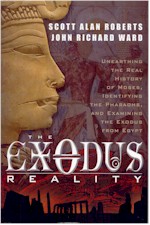 |
|
|
| ||||||
|
|
This page is the original source of this review, though you may also find it on Amazon or other sites. | ||
| Book Reviews Home | Free Audio Books | |
 |
Book Review of: The Exodus RealityUnearthing the Real History of Moses, Identifying the Pharaohs, and Examining the Exodus from Egypt Price: $13.00 Availability: Usually ships within 24 hours |
| Review of
The Exodus Reality, by Scott Alan Roberts and Dr. John Richard Ward (Softcover, 2013) (You can print this review in landscape mode, if you want a hardcopy) Reviewer: Mark Lamendola, author of over 6,000 articles. What do we really know about Moses? Set aside biblical accounts, and what corroborating evidence do you have? There's no mention of Moses per se in any of the surviving written records or other artifacts of the period in which he is supposed to have lived. The authors acknowledge this documentation gap, but then propose two possible sets of corroboration based on the available evidence. By "sets of corroboration" I mean the book contains two scenarios by which an actual historical figure under a name other than Moses could have been the actual Moses. Roberts presents one scenario, and Ward the other. Each co-author follows a different theory, and the theories run as threads through the book.
To avoid confusing the reader, each chapter follows one thread or the other, and the thread being followed is stated at the beginning. Something I really like about their approach and general tone is neither author pretends to have "the answer." In fact, they are very clear on this and make an effort to avoid giving any such impression. The very structure of the book (two possible theories) avoids this, but also throughout the text the authors say things like this particular idea is something you accept on faith because it can't be proven but it's logical enough that it might be proven if you could find the evidence.
I won't go into the details of their qualifications, but I'm satisfied that the authors are heavyweights in the area of study covered by this book. I've read other books that give a good presentation of what might be the reality, but the author has an agenda and concludes that a likely possibility is the only possibility. So I want to stress the point that Ward and Roberts are clearly not doing any such thing. Having finished the book and become familiar with each theory, I have no preference of one over the other. Either one could be right. This book runs 197 pages of text, which is laced with excellent black and white photography and illustrations (so the actual text is something less than that). Having worked a long time in the trade publication industry (author, editor), I know how hard it is to get photos that actually add to the text in a meaningful way versus gratuitous "glory shots" added just for the sake of having graphics. An outstanding job, here. The book also has a set of brilliant captioned photographs (8 pages) inserted between pages 96 and 97, and a second set (8 pages) inserted between pages 192 and 193. Prior to the text are the Acknowledgement, TOC, Foreword, Preface by Dr. Ward, Preface by Scott Alan Roberts, and Introduction. Collectively, these take up 47 pages. The book's actual text starts on page 49 (page 48 is blank). Appendix A is a long (19 pages) poem called The Admonitions of an Egyptian Sage. Appendix B (2 pages) is The Oxford History of Ancient Egypt; it lays out the dates of the various dynasties in chronological order, starting with the 18th Dynasty (1550 to 1069 BC) and ending with Horemheb (1323 to 1295 BC). Note that these are not sequential; there is considerable overlap as many of these are largely concurrent. The notes and bibliography are a bit on the scant side, but then one must consider that this book wasn't intended as a tertiary work. The authors presented a great deal of primary research conducted in person onsite. You can tell this is the case just from the photos alone, but it's also supported in the text. Something that was distracting during the reading of this book is the fact it's rife with errors in spelling and grammar. I think that, given the price range and the audience demographic, there just isn't funding for good copyediting. My thought on this is the authors chose to make this work available to the typical public consumer rather than relegating it to limited academic circles. It's a scholarly work. If snuffed up to college textbook form, a $75 to $99 price tag would not surprise me. By putting it in paperback and leaving the grammar gaffes and misspellings fall where they may, the authors can share their research with a much wider audience. This was probably the correct decision. | |
| |||||